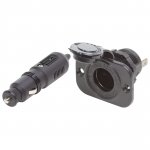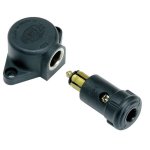Martinjmpr
Wiffleball Batter
We have an inexpensive 100W "solar kit" (HQST) that we've been using on our camper for the past 4 years or so. It works well, the panel folds and goes into a nice little carrying case and we connect it to the battery (2 x 6v FLA golf cart batteries) on our trailer when we are camping without power.
One of the projects I've set myself to work on this year is to move my solar controller from its current position on the back of the solar panel up to a position closer to the battery. I'm planning on building a waterproof controller box to sit on the tongue of the trailer and I will then plug the solar panel directly into the controller, which will be permanently connected to the battery.
With my current setup (solar controller attached to the panel) there is a short set of heavy gauge, stiff wires connecting the panel's power output to the controller. Then, from the controller, I put a Battery Tender SAE harness on, and another SAE harness on the battery on the camper, and I connect the two with a 25' SAE "extension cable" that has SAE connectors on both sides. Having the 25' cable lets me position the panel so it gets the most possible sunlight exposure for the maximum charge to my batteries.
From what I can see, the SAE harness and extension cable are all 16 gauge.
In theory, a 100W panel at full power could produce as much as 8.3A (100W / 12v) but I presume that unless I'm sitting at the equator under a cloudless sky, I'm going to get less. Looking at the Wire Barn wire gauge calculator, it seems to me I'm already marginal in terms of my wiring gauge (according to this, even at a nominal power rating of 7A, I should be using 10AWG.)
My thought behind moving the controller is this: First of all, by having the controller close to the battery instead of 25' away, it should reduce power loss due to the length of the cable. This means more power to the battery and easier to keep the battery fully charged. Also, I could upgrade to a better quality MPPT charger instead of the cheap PWM charger that's on there now (which I think is limited to 20A.) Finally, although I have never had any issues despite having the panels and controller set up during a sudden rainstorm, my PWM controller is not technically rated as being "waterproof" so building a waterproof enclosure for the controller seems to be something that would be prudent.
With all that said, here are my questions for the group:
1. Assuming the distance from the controller to the battery is less than 2' (which it should be), a 16G or even 18G wire from the controller to the battery should be fine.
But what about from the panel to the controller? My panel originally came with some heavy gauge (and very stiff) cables with MC4 connectors. My understanding is that the panel itself puts out ~19v and that the controller "steps down" this power to a regulated ~14v output to the battery.
If I'm looking at these charts and calculators correctly, for a 19v output from the panel to the controller and ~25' of length, I'm going to need at least 12 or even 10g wiring, correct? Or have I miscalculated something?
2. Is there any reason to prefer the stiff (and difficult to store or work with) cabling that seems to come with solar panels over more pliable automotive wiring of the same wire gauge? And finally:
3. Is there any reason to prefer MC4 connectors over some other type of quick-disconnect connector? Seems to me an Anderson-type connector would work as well or better than MC4 but for whatever reason, MC4 seems to have become the "industry standard" for portable solar power packs.
Thanks in advance for any advice or recommendations!
One of the projects I've set myself to work on this year is to move my solar controller from its current position on the back of the solar panel up to a position closer to the battery. I'm planning on building a waterproof controller box to sit on the tongue of the trailer and I will then plug the solar panel directly into the controller, which will be permanently connected to the battery.
With my current setup (solar controller attached to the panel) there is a short set of heavy gauge, stiff wires connecting the panel's power output to the controller. Then, from the controller, I put a Battery Tender SAE harness on, and another SAE harness on the battery on the camper, and I connect the two with a 25' SAE "extension cable" that has SAE connectors on both sides. Having the 25' cable lets me position the panel so it gets the most possible sunlight exposure for the maximum charge to my batteries.
From what I can see, the SAE harness and extension cable are all 16 gauge.
In theory, a 100W panel at full power could produce as much as 8.3A (100W / 12v) but I presume that unless I'm sitting at the equator under a cloudless sky, I'm going to get less. Looking at the Wire Barn wire gauge calculator, it seems to me I'm already marginal in terms of my wiring gauge (according to this, even at a nominal power rating of 7A, I should be using 10AWG.)
My thought behind moving the controller is this: First of all, by having the controller close to the battery instead of 25' away, it should reduce power loss due to the length of the cable. This means more power to the battery and easier to keep the battery fully charged. Also, I could upgrade to a better quality MPPT charger instead of the cheap PWM charger that's on there now (which I think is limited to 20A.) Finally, although I have never had any issues despite having the panels and controller set up during a sudden rainstorm, my PWM controller is not technically rated as being "waterproof" so building a waterproof enclosure for the controller seems to be something that would be prudent.
With all that said, here are my questions for the group:
1. Assuming the distance from the controller to the battery is less than 2' (which it should be), a 16G or even 18G wire from the controller to the battery should be fine.
But what about from the panel to the controller? My panel originally came with some heavy gauge (and very stiff) cables with MC4 connectors. My understanding is that the panel itself puts out ~19v and that the controller "steps down" this power to a regulated ~14v output to the battery.
If I'm looking at these charts and calculators correctly, for a 19v output from the panel to the controller and ~25' of length, I'm going to need at least 12 or even 10g wiring, correct? Or have I miscalculated something?
2. Is there any reason to prefer the stiff (and difficult to store or work with) cabling that seems to come with solar panels over more pliable automotive wiring of the same wire gauge? And finally:
3. Is there any reason to prefer MC4 connectors over some other type of quick-disconnect connector? Seems to me an Anderson-type connector would work as well or better than MC4 but for whatever reason, MC4 seems to have become the "industry standard" for portable solar power packs.
Thanks in advance for any advice or recommendations!



